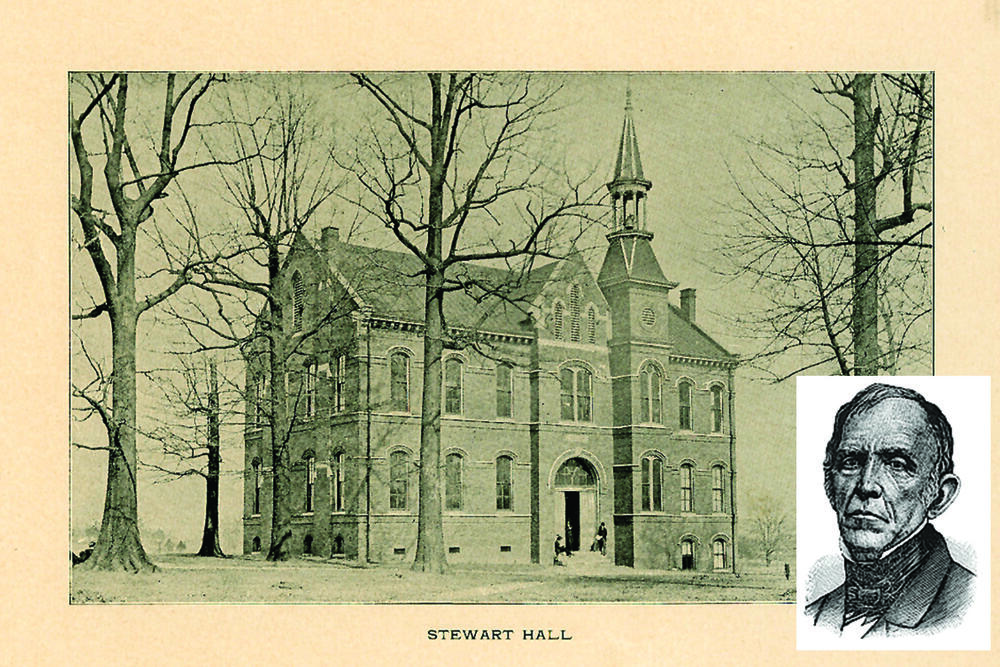During its first three decades, the college founded in Clarksville, Tennessee, in 1848 had four different names and seven different presidents. It was an inauspicious beginning for Rhodes College, now celebrating its 175th anniversary.
Relatively little is known about the men who initially led what began as the Masonic University of Tennessee. In the institution’s first five years, four presidents served in rapid succession. W.F. Hopkins and Richard Nelson Newell were the institution’s first two presidents, each for a year, after which William A. Forbes served from 1850 to 1853. By this time, the Masonic University of Tennessee had become Montgomery Masonic College, named for the county in which it was located.
The college’s fourth president, William May Stewart, stands out as the first figure of significance. A Philadelphia native who had settled in Middle Tennessee and made a fortune in the iron industry, Stewart joined the faculty of the college as a professor of natural sciences and helped fund the construction of its first permanent building, nicknamed “the Castle.” A distinguished scientist, Stewart was renowned for his collection of minerals and fossils, as well as his large library.
Stewart became president in 1853, and two years later the Board renamed the college in his honor after he negotiated the sale of the school to the Presbyterian Synod of Nashville. The church affiliation, it seemed, promised to put the college on a secure financial footing. Stewart stepped down from the presidency in 1858, and R.B. McMullen, an ordained Presbyterian minister, succeeded him.
The college’s troubles were far from over, as McMullen’s brief term coincided with the American Civil War. Tennessee seceded from the Union in 1861, and the College closed months later when all but two of its students went off to fight for the Confederacy. In early 1862, Union military victories at nearby forts Henry and Donelson led to Union occupation of Clarksville. The College’s only dormitory, Robb Hall, became a hospital, where President McMullen worked as a nurse. He eventually contracted smallpox and died in 1865.
Clearly, the college paid a price for its connection to the Confederacy. As one account put it, “Stewart College suffered severely during the war. Its library, cabinets, and apparatus were swept away and for several years its doors were closed.” When the college managed to repair its buildings and re-open in 1869 during the Reconstruction Era, it did so under the leadership of Stewart, who returned as acting president for a year.
In 1870, J. B. Shearer assumed the presidency of Stewart College and served nine years, the longest tenure of any president until that time. Shearer worked with prominent Presbyterian leader Rev. Benjamin Palmer to negotiate the Plan of Union, which united the various Presbyterian synods of the Southwest in support of Southwestern Presbyterian University, the new name for the school. Having transformed the struggling institution from a college under the control of a local synod to a university for all Presbyterians of the Southwest, Shearer retired. At that point, after the Board unsuccessfully attempted to convince Palmer to lead the university, Rev. John N. Waddel became the institution’s seventh leader—and the first to claim the title of “chancellor.” A native of Memphis and former chancellor of University of Mississippi, Waddel served for the next nine years.
By the late 1870s, after it had become Southwestern Presbyterian University in 1875, the institution founded in Clarksville had survived three decades of tumult and transition—which included one civil war, four names, and seven presidents. It had achieved at least a modicum of stability. Under the leadership of Shearer and then Waddel, the school solidified its connection to Presbyterianism and for the first time included “Southwestern” in its name.
Timothy S. Huebner
Sources:
Cooper, W. Raymond. Southwestern at Memphis, 1848-1948 (1949).
Merriam, Lucius Salisbury. Higher Education in Tennessee (1893).
Wood, Bennett. Rhodes, 1848-1998: A Sesquicentennial Yearbook (1998).
Back to Celebrate 175 Years of Rhodes
